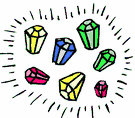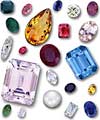GEMSTONES
Basis of Selection of Gems

Basis of Selection of Gems
The main criteria for the choice of a gemstone is it's color. Vedic Astrology principles recommend selection of a gemstone on the basis of the following criteria:
Vedic Sun Sign
When birth data, like date, place and time of birth, are doubtful or unknown, a gemstone on the basis of the Sun Sign, selected from the month of birth, is recommended as per the following table:
| Sun Sign | Gemstone |
| Aries | Red Coral |
| Taurus | Diamond, White Sapphire, Zirconium |
| Gemini | Emerald |
| Cancer | Pearl, Moonstone |
| Leo | Ruby |
| Virgo | Onyx, Peridot |
| Libra | Blue Sapphire, Amethyst, Lapis Lazuli |
| Scorpio | Hessonite, Brown Tourmaline |
| Sagittarius | Yellow Sapphire, Citrine |
| Capricorn | Turquoise |
| Aquarius | Red Garnet |
| Pisces | Yellow Sapphire |
Date of Birth (Janma Tithi)
Each day is ruled by one of the eight planets from Sun to Rahu. A gemstone is recommended based on the ruler ship of the day of birth. This method is not a very popular basis for selection of gemstones.
Weekday of Birth (Janma Vara)
Each day of the week is named after one of the seven planets ( from Sun to Saturn) and is ruled by that planet. A gemstone is recommended based on the ruler ship of the day of the week. Once again, this method is no longer a very popular basis for selection of gemstones.
Ascendant (Janma Lagna)
The Lord of the Ascendant (Lagnesh) is the controller of life forces (jeeva). Based upon the determination of the Ascendant, a gemstone is recommended to be worn as a ring on the ring finger.
Planetary Periods (Dasa)
The rulership of the current planetary period (Dasa) or sub-period (Antardasa) is very often used for selection of a gemstone to bring relief from malefic effects of the ruler or to enhance its benefic effects.
Gemstones as Mascots

Agate - Farmers, Gardeners.
Amethyst - Hunters,Businessmen, Sportspersons, Lovers
Aquamarine - Sailors, Sweethearts.
Bloodstone - Farmers, Soldiers.
Cat's Eye - Gamblers.
Coral - Children, Mothers.
Emerald - Sailors, Fishermen.
Garnet - Travellers.
Jade - Gamblers.
Lodestone - Sailors
Sapphire - Lovers.
Turquoise - Lovers, Married ones, Horse riders.
INDIAN GEMOLOGY
Precious and Semi-Precious Stones
Actually the gem stones found at present are innumerable but according to the specialist of Indian Gemmology there are 84 gem stones. Amongst them nine – Ruby, Pearl, Emerald, Yellow or White Sapphire (Pukhraj), Diamond, Blue Sapphire, Gomedha and Cat’s Eye occupy the prestigious category of Navratnas. Five of them viz. Ruby, Pearl, Diamond, Emerald and Blue Sapphire have been given the distinction of being termed as Maha Ratnas (superior most class of gems). These are also precious stones and the others are classed as semi precious stones. But there are several semi precious stones which by their brilliance and luster do not look inferior to some of the above mentioned Nav Ratnas(nine gems). In hardness, durability, scarcity, luster and transparency they do not lag behind the Nav Ratnas like Emeralds, Gomedha, Cat’s Eyes and Sapphire.These stones are very importent for us.
The Eighty-four Gems of Indian gemology are as under:
(1) Ruby: This is of color red. This is a precious stone and is very costly. Ruby is found in rosy, blackish and sky like colors also.(For sun )
(2) Diamond: This is found in white, yellow, rosy, red, blue and black colors.( For sukra )
(3) Emerald: It is green, in bottlelike color or tarnish white.( For Mercury )
(4) Blue Sapphire: Some call it only sapphire. This gem is found in dark, ordinary or light blur colors.( For starun )
(5) Cat’s Eye: This is yellowish or blackish in color. Inside the stone is visible a shining band which moves when the stone is turned. Because of the band the gem is also called Sutra Mani. (For ketu )
(6) Pearl: This is found in white, red, yellow or black colors. Rosy color pearls are also seen. ( For Moon )
(7) Coral: Generally Corals are found in red and sindoori colors. White corals are also available. They are a later discovery. ( For mars )
(8) Yellow(or white) Sapphire: This is found in yellow( dark and light, generally in light yellow), white and blue colors. Actually the one having blue color becomes Blue Sapphire. Ancients called it ‘Pushpaag’(Jupitor )
(9) Gomedha: It is said that this gem belongs to the zircon family. It's color is like red colored smoke. Some have given its color as that of honey and other as the urine of cow. ( Rahu )
(10) Lalri: This has the color of rose ( light red - ).
(11) Turquoise: This has sky like color.
(12) Peridot: This is of very light green color.
(13) Opal: This is available in all colors. The one with white color has also slight sparkling of other colors. Multi-colored opals are also found.
(14) Tourmaline: This is a soft stone but is available in white, red, green, brown and many other colors. This is a very effective gem stone and has many qualities. Multicolored gems are also found.
(15) Spinel Ruby: This has darkish and yellowish red color.
(16) Topaz: This is also citrine. This has light golden color.
Golden topaz looks very attractive.
(20) Amethyst: This is of light or dark violet color.
(18) Gold Stone: This is orangish red color with spots of golden color. This is a very soft and weak stone.
(19) Rock Crystal: This is of shining white color. If cut finely it looks like white Topaz.
(20) Moon Stone: This has the color of a white cloud or tooth of a cow. Inside the stone there is a glistening band, which rolls when the stone is turned.
(21) Romni: This is a soft stone of dark red color with a blackish tinge.
(22) Garnet: This is of blackish red color.
(23) Ludhya: This is of red color.
(24) Maryam: This is of shining white color.
(25) Load Stone: This is also called Chamak stone. This is of white color tending to be blackish.
(26) Sindooria: This is of light rosy color.
(27) Neeli: This is a soft stone resembling Blue Sapphire.
(28) Smoky Quartz: This is of smoky light golden color.
(29) Aquamarine: This is of light green color. It is mistaken for Emerald. Aquamarine is more transparent than emerald and is much less expensive.
(30) Jade: This is green in color but without brilliance or luster. It is very cheap stone.
(31) Blood stone: This is of green in color with red spots over it.
(32) Banshi: This is a soft stone of green color.
(33) Durvenajf: This has color of unripe paddy.
(34) Suleimani: This is a stone of black color with white stripe on it.
(35) Alaimani: This is brown in color. Belongs to the Suleimani family.
(36) Jajemani: This also belong to the Suleimani family. It is of brown color with white stripes on it.
(37) Tursava: It is a soft stone of yellowish red color.
(38) Ahwa: This is a stone of rosy color.
(39) Aabri: This is stone of black color.
(40) Savore: This is a stone of green color white brown stripe on it.
(41) Lapis Lazuli: This a soft stone of blue color. In ancient times in western countries it was recognized as Blue Sapphire.
(42) Kudurat: This is of black color with dots of yellow and white color.
(43) Chitti: This is a stone with a stripe of gold like color.
(44) White Jade: This is a white stone with the hue of grapes.
(45) Laroo: This is a kind of marvar stone.
(46) Marvar: This stone is found in three colors- bamboo like, red and white.
(47) Kidney Stone: This stone is light green in color.
(48) Kasauti: This is used to test the purity of gold.
(49) Darchana: It is of the color of darchana.
(50) Haqiq-al-bahar: This comes out from watery places. The color of this stone is yellowish green.
(51) Halan: This is a stone of rosy color. The color rolls when the stone is moved.
(52) Seejri: This is a white colored stone with impression of a tree on its body.
(53) Mubenajf: This is a white colored stone with thin hair like black line or lines.
(54) Amber: This is of dull wheatish color.
(55) Jhana: This is a very soft stone. A touch of water destroys the stone.
(56) Sang Basri: This is used to make surma (a medicinal grey powder) for eyes.
(57) Dantla: This is yellow in color.
(58) Makra: This is a black stone with the impression of a spider’s web on it.
(59) Sangeeya: This is white in color.
(60) Goodri: This is a favourite stone of Muslim religion people.
(61) Kamla: Whitish green.
(62) Sifri: Green and sky blue color mixed.
(63) Hareed: Black – brownish. Used for making rosaries.
(64) Hawas: This is green colored with a golden tinge.
(65) Seengli: This stone belongs to the ruby family but it is much softer and inexpensive stone. This is of red colour inclined to blackish ness.
(66) Dhedi: Black – used for making cups and saucers etc.
(67) Agate: This is found in various colors. It is a very inexpensive lasting stone. It is considered very auspicious and effective by Muslim saints. It is also used as a birth stone.
(68) Gouri: This is also available in various colors. It has white stripes. This is used for making measuring weights for jewelers.
(69) Seeya: This is black in color and is used to make statues.
(70) Seemak: This is of red color with a yellowish tinge. There are rosy colored sprinklings on it. This is used for making mortars in which medicines are triturated.
(71) Moosa: White dusty colored, used for making bowls.
(72) Panghan: Black – used for making toys.
(73) Amleeya: Dark rosy used for making mortar.
(74) Door: Dark brown used for making mortars.
(75) Liliar: Black – used for making mortar.
(76) Khara: Greenish – used for making mortar.
(77) Para zahar: Its colored like a white bamboo. It has medicinal properties. Its paste heals wounds rapidly.
(78) Gypsum: Dusty colored used for making toys.
(79) Zahar Mohra: Greenish. It is believed that poison if put in a cup made of this mineral loses its evil effect.
(80) Rawaat: This is found in red and blue colors. The stones give relief in fevers. The blue ones have medicinal utility.
(81) Sohan- Makhki: Looks like white clay. Considered useful for urinary trouble.
(82) Hazrat-e-ood: Black – used for making medicines for eyes in the Unani system of medicine.
(83) Surma: Black.
(84) Paras: Iron turns into gold by this stone. It is a very rare stone and very few have seen it.
We find it difficult to accept many of the stones mentioned in the above list as gems stones but according to Indian Gemmology all these have been recognized as such. It is possible that many of them may be known in the country by different names but we have not been able to find their English equivalent. From amongst 84 gems mentioned here the following stones can be used for planetary affiliations because of their color, durability, hardness, luster and beliefs about them.
Spinel, Turquoise, Peridot, Opal, Tourmaline, Topaz, Amethyst, Rock Crystal, Moonstone, Garnet, Neeli, Aquamarine, Jade, Blood Stone, Lapis-Lazuli and Agate.
Every stone has their own special quality. Specific Gravity, hardness & Different Colours and their effect is also very important that is why we have to be very carful while assigning you your stone.
Er. Rameshwar Prasad invites you to the Wonderful World of Indian Astrology.
Engineer Rameshwar Prasad(B.Tech., M.Tech., P.G.D.C.A., P.G.D.M.) Vaastu International
|

